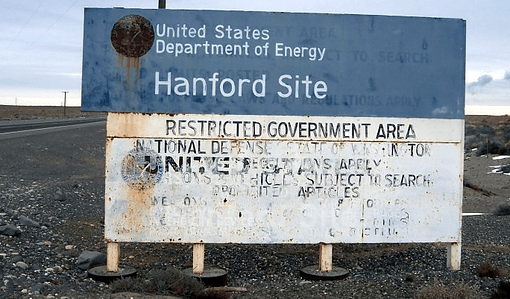Hanford’s Leaky Nuke Tanks and Sick Workers, a Never-Ending Saga in the U.S.
ENVIRONMENT, 9 May 2016
4 May 2016 – It’s been a toxic few weeks at the Hanford nuclear reservation in Eastern Washington. Not that this is exactly news — Hanford is the most radioactive site in North America and is thereby always toxic. But what is news is how dangerous and negligent the remediation efforts at Hanford continue to be.
The original Hanford Project, which manufactured plutonium for the world’s first atomic bomb and over its forty years of operation produced 63 short tons of plutonium, is now home to the largest environmental clean-up in the country. The place is literally steaming with radioactivity. 56 million gallons of nuclear sludge currently sit in double-walled underground tanks built in the 1970s. This waste is awaiting a plant to be built, known as the Hanford Vit Plant, that can turn the nasty gunk into glass rods. The Vit Plant, to be constructed by Bechtel, continues to run way over its initial budget estimates and keeps being delayed. The plant, if it’s ever completed, will end up costing taxpayers over $30 billion. Meanwhile, those old holding tanks aren’t fail-safe. They continue to be a colossal problem for the environment and workers alike.
One of the tanks, known as AY-102, began leaking in 2012 and now another, AY-101, is purportedly well on its way. The Department of Energy, the agency in charge of handling Hanford’s nuke mess, says AY-101 isn’t leaking yet, but tells Gizmodo the tank is simply releasing “higher than normal readings for contamination.”
Ho-hum. Nothing to smell here.
The leak from AY-102, which filled in between the inner and outer wall of the tank, continues to be problematic with clean-up efforts ongoing. However, on Thursday, April 28, work to drain the leak was stopped after a foul odor was reported by workers. By Friday, 20 employees of Washington River Protection Solutions, the DOE contractor on the project, were tested for potential exposure to chemical vapors.
“The fact that these vapor exposures occurred outside the so-called vapor control zones — an area where workers are supposedly safe from exposure — illustrates the extent of ineffectiveness of Hanford’s worker protection program,” says Tom Carpenter, director of the Seattle-based watchdog group Hanford Challenge. “Hanford officials responded with the same tired excuses that none of the samples of air they took were above permissible limits. Should we believe 20 workers who suffered nosebleeds, headaches, dizziness and shortness of breath in the course of a couple of hours, or Hanford’s assurances?”
Good question.
Carpenter adds that Hanford doesn’t perform any real-time monitoring for dozens of toxic chemicals likely emanating from those leaky tanks. Nor does Hanford factor in the mixture rule, an OSHA-directive that requires the lowering of acceptable limits when multiple chemicals are present. In other words, Hanford workers are put at risk of chemical exposure and the DOE and its contractor don’t give a shit.
This isn’t new stuff for Hanford. In 2014 more than 40 workers suffered ailments caused by chemical exposures and last March 26 workers were sent to a hospital or clinic. Such accidents prompted Hanford Challenge, Washington Physicians for Social Responsibility, union Local 598, and the Washington Attorney General to bring legal actions in federal court to force the DOE to protect workers from these extensive hazards. Here’s to hoping those suits move along faster than Hanford’s clean-up efforts.
________________________________________
This piece originally appeared at The Investigative Fund.
Joshua Frank is managing editor of CounterPunch. His most recent book is Hopeless: Barack Obama and the Politics of Illusion, co-edited with Jeffrey St. Clair and published by AK Press. He can be reached at brickburner@gmail.com.
Go to Original – counterpunch.org
DISCLAIMER: The statements, views and opinions expressed in pieces republished here are solely those of the authors and do not necessarily represent those of TMS. In accordance with title 17 U.S.C. section 107, this material is distributed without profit to those who have expressed a prior interest in receiving the included information for research and educational purposes. TMS has no affiliation whatsoever with the originator of this article nor is TMS endorsed or sponsored by the originator. “GO TO ORIGINAL” links are provided as a convenience to our readers and allow for verification of authenticity. However, as originating pages are often updated by their originating host sites, the versions posted may not match the versions our readers view when clicking the “GO TO ORIGINAL” links. This site contains copyrighted material the use of which has not always been specifically authorized by the copyright owner. We are making such material available in our efforts to advance understanding of environmental, political, human rights, economic, democracy, scientific, and social justice issues, etc. We believe this constitutes a ‘fair use’ of any such copyrighted material as provided for in section 107 of the US Copyright Law. In accordance with Title 17 U.S.C. Section 107, the material on this site is distributed without profit to those who have expressed a prior interest in receiving the included information for research and educational purposes. For more information go to: http://www.law.cornell.edu/uscode/17/107.shtml. If you wish to use copyrighted material from this site for purposes of your own that go beyond ‘fair use’, you must obtain permission from the copyright owner.
